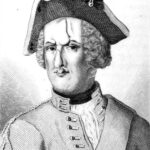30 August 1766: Organ-builder John Snetzler selects an organist for Halifax parish church

A 40-foot bourdon, sorry, telescope built by William Herschel at Slough for George III (Anon 1800ish).
William Cudworth. 1889. Life and Correspondence of Abraham Sharp, the Yorkshire Mathematician and Astronomer, and Assistant of Flamsteed. London: Sampson Low, Marston, Searle and Rivington. Get it:
.Excerpt
Herschel’s chief opponent at the trial performance was Dr Robert Wainwright, a popular composer, and on the day of trial the famous German organ builder, Johann Snetzler, who built the organ, was present. Wainwright was the first to be tested, and in the “thin” style of organ playing of that period he sought to manifest his ability by rapidity of execution. So little did this, however, meet with the approval of the excitable builder, that he ran about the church angrily crying: “Te teyvel, te teyvel, he run over de keesh like von cat – he will not gif my pipes room for to shpeak!” When it came to Herschel’s turn to play, he ascended the organ loft, and produced from the instrument such a volume of slow, sustained harmony as captivated all present – the delighted organ builder exclaiming “Aye, aye, tish is vary goot, vary goot indeed. I will haf tish man, he gifs my pipes room for to shpeak.” Herschel was at once appointed organist at a stipend of 52 guineas a year. He soon afterwards removed to Bath, where he turned his attention to astronomy. Here he constructed a telescope of large dimensions, and in 1781 announced the discovery of a supposed comet, which soon proved to be the planet Uranus. He was thereupon appointed private astronomer to the King, with a salary of £400 per annum, and abandoned the musical profession.
Comment
Comment
Cudworth confuses William with son John, but in other respects the anecdote seems feasible. Herschel didn’t stay long in Halifax: on 1 January 1767, he gave his introductory concert as organist of the Octagon Chapel, Bath, where he also initiated a Snetzler instrument.
Let me turn ‘the “thin” style of organ playing’ around in my head and get back to you.
Something to say? Get in touch
Original
Herschel’s chief opponent at the trial performance was Dr. Robert Wainwright, a popular composer, and on the day of trial the famous German organ builder, Johann Snetzler, who built the organ, was present. Wainwright was the first to be tested, and in the “thin” style of organ playing of that period he sought to manifest his ability by rapidity of execution. So little did this, however, meet with the approval of the excitable builder, that he ran about the church angrily crying: “Te teyvel, te teyvel, he run over de keesh like von cat – he will not gif my pipes room for to shpeak!” When it came to Herschel’s turn to play, he ascended the organ loft, and produced from the instrument such a volume of slow, sustained harmony as captivated all present – the delighted organ builder exclaiming “Aye, aye, tish is vary goot, vary goot indeed. I will haf tish man, he gifs my pipes room for to shpeak.” This was on August 30th, 1766, and Herschel was at once appointed organist at a stipend of fifty-two guineas a year. He soon afterwards removed to Bath, where he turned his attention to astronomy. Here he constructed a telescope of large dimensions, and in 1781 announced the discovery of a supposed comet, which soon proved to be the planet Uranus. He was thereupon appointed private astronomer to the King, with a salary of £400 per annum, and abandoned the musical profession.
242 words.
Similar
 8 June 0793: Alcuin of York, a leading figure in the Carolingian Renaissance, reflects in a poem on the devastation this day of Lindisfarne by Vikings
8 June 0793: Alcuin of York, a leading figure in the Carolingian Renaissance, reflects in a poem on the devastation this day of Lindisfarne by VikingsSearch
Donate
Music & books
Place-People-Play: Childcare (and the Kazookestra) on the Headingley/Weetwood borders next to Meanwood Park.
Music from and about Yorkshire by Leeds's Singing Organ-Grinder.



 Bluesky
Bluesky Extwitter
Extwitter